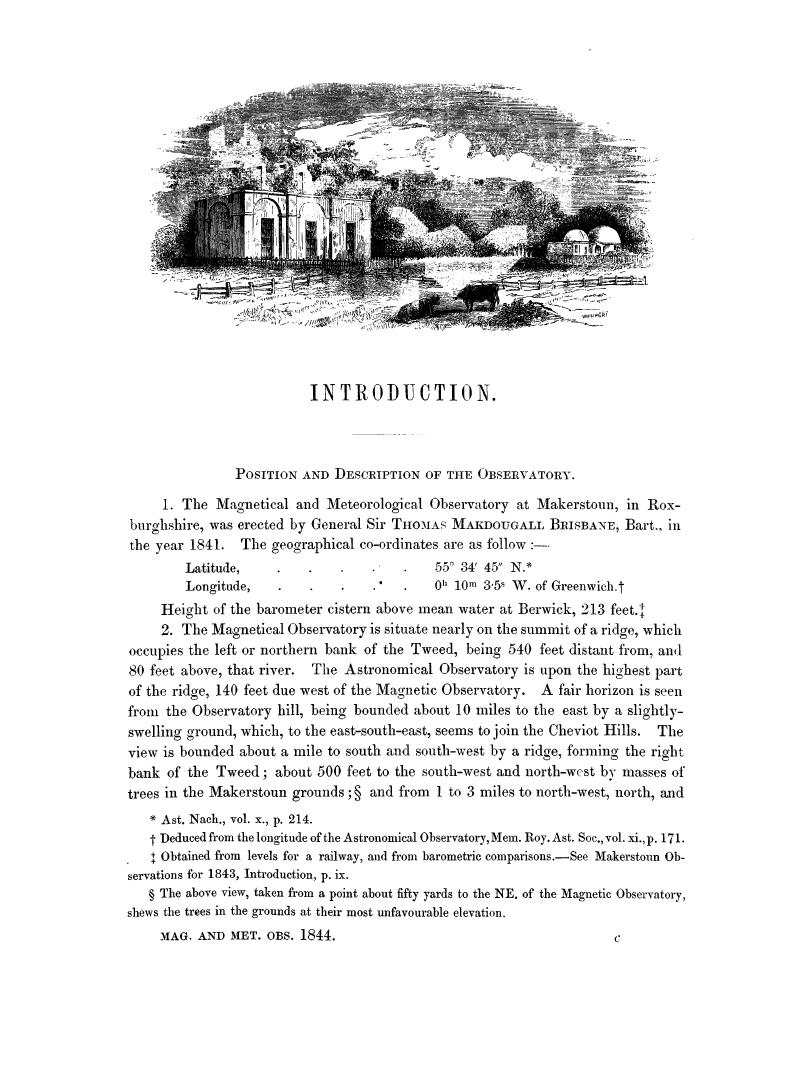No CrossRef data available.
Article contents
Introduction
Published online by Cambridge University Press: 17 January 2013
Abstract

- Type
- Introduction
- Information
- Copyright
- Copyright © Royal Society of Edinburgh 1848
References
page ix note * Ast. Nach., vol. x., p. 214.
page ix note † Deduced from the longitude of the Astronomical Observatory, Mem. Roy. Ast. Soc., vol. xi., p. 171.
page ix note ‡ Obtained from levels for a railway, and from barometric comparisons.—See Makerstoun Observations for 1843, Introduction, p. ix.
page ix note § The above view, taken from a point about fifty yards to the NE. of the Magnetic Observatory, shews the trees in the grounds at their most unfavourable elevation.
page xii note * For details, see Introduction to the Observations for 1843, pp. xiii, and xiv.
page xiii note * For details, see Introduction to the Observations for 1843, pp. xv, and xvi.
page xiii note † Ibid., pp. xvii. and xxi.
page xv note * See Introduction, 1843, pp. xvii. and xviii.
page xvi note * See Introduction, 1843, p. xxi.
page xxi note * See Introduction, 1843, p. xliii.
page xxv note * It will in general be preferable to place tlie deflecting bar to the east or west (as in the present observations), rather than to the north or south of the bifilar magnet, since I have found that the centre of figure may differ considerably from the centre of magnetism; perhaps, for the same reason, when observations are made only on one side of the bifilar magnet, the deflecting bar should be inverted when it is reversed, since the magnetic axis may be nearer one side of the bar than the other.
page xxxiii note * Introduction, 1843, p. xxxiii.
page xxxiii note † In 1847, it was found more convenient during disturbances, to bring the scale of the bifilar magnet into the field of the reading telescope, by means of a small deflecting magnet placed on a beam of wood at known distances from the centre of the bifilar magnet. The effect of the deflecting magnet was afterwards determined with the aid of a second deflecting bar.
page xxxiii note ‡ Introduction, 1841–2, pp. xxviii., xxix.
page xxxv note * See Dr Lloyd's Account of the Magnetical Observatory of Dublin, p. 38.
page xxxv note † Introduction, 1843, p. xxxviii.
page xxxv note ‡ Introduction, 1841–2, Table 15, p. xxxv.
page xxxix note * See Transactions of the Royal Society, Edinburgh, vol. xvi., p. 69, Table I.
page xxxix note † Ibid., p. 72, Table IV.
page xlvii note * If the scale readings increase with increasing horizontal force, Δ R will generally be negative when Δ t is positive, and vice versa. The sign of Δ t is used as the argument, so that if 〉 R be positive when Δ t is positive, that value of Δ R will be subtracted from the sum of differences ∑ 〉 R.
page xlviii note * See foot-note, p. 395 of the present volume.
page xlix note * It should be remarked, that these conclusions do not depend wholly upon the results for the Makerstoun instruments, their accuracy has been verified by an examination of the observations made in other places.
page l note * See foot-note, p. 395 of the present volume.
page liii note * Observations were made in the following manner for the determination of the magnetic dip in February 1846. The dipping needle having been placed on its supports in the inclinometer, it was deflected by a magnet placed at known distances, in order to determine the ratio of the magnetic moment of the deflecting bar to the vertical component of the earth's magnetism; the moment of the bar was obtained from observations of deflection and vibration for the absolute horizontal intensity, whence the vertical component could be determined, and the dip from the ratio of the two components. The advantage of this method over others, consists in the capability of using a powerful deflecting bar whose moment can be determined with the accuracy of the observations for the horizontal intensity.
page lvi note * The cause of this apparent anomaly in frosty nights, it is conceived, is due to the deposition of moisture on the silk cover of the wet bulb, which is frozen as it is deposited, till it becomes a thickish coat of silk and ice; the dry bulb receives, at the same time, a thin coat of moisture, and becomes a more facile wet bulb. In clear, humid nights, without frost, nearly the same explanation will apply; the dry bulb will radiate its heat into space with more facility than the wet bulb. It might be preferable, therefore, on these occasions, to make use of the readings of the wet bulb for the temperature of the air, and of the readings of the dry bulb for the temperature of evaporation during frosty nights; where, however, the differences of the readings may be considered due chiefly to the different radiating powers of the two bulbs, the readings, perhaps, should be considered the same; this has been done in all cases in the present volume.
page lxii note * The application of the involute of the circle as the spiral is due, I believe, to Professor Forbes. It is easily shewn that if the vessel e be homogeneous, w being the weight of a ring whose depth is one inch, P the pressure which the wind exerts on the top of e diminishing its weight, β the corresponding are through which the circumference of the wheel f moves (or the length of cord wrapped on the wheel), W the weight of the counterpoise k, and σ the specific gravity of the material (zinc) of which e is formed, then




